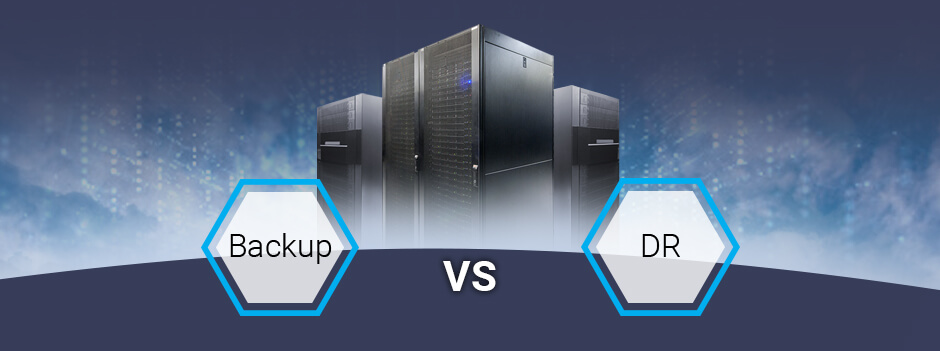Modern businesses increasingly depend on cybersecurity and the stability of IT system operation. System failures can often paralyse a company, leading to significant losses, unhappiness among clients, and a worse reputation.
The risk of business interruption is considered to be among the most severe ones, and companies use a whole slew of measures to ensure business continuity.
In this blog we will talk about what data backup and disaster recovery are. How do these tools for restoring system operation after an incident function? What are their main differences and what effect do they have on business continuity?

– means making a copy of the data on another storage device (an external hard drive, a CD/DVD, a flash drive, cloud storage etc.).
makes it possible to restore data and the function of the software and the operating system after a hardware failure or data loss.
Data leaks, personal data protection, cyber incidents: these and similar topics currently attract more and more attention during business meetings.
The disaster recovery plan is an integral component of the IT strategy of any business, because IT security breaches and infrastructure failures are spreading, while the losses caused by such incidents are on the rise.
According to Allianz1 data, during the last five years, an average IT incident caused two million euros in damage, which is more than the losses created by fires and explosions.
When making decisions on their IT security strategy, company managers often think that data backup alone is a sufficient precautionary measure for if their infrastructure fails, or any other incident takes place. But is this actually true?
Both these tools make it possible to restore the operation of individual system components, and to restart crashed services. Both of them can save a company’s business when its servers or software fail. These tools are very similar, in a way.

"Without question, data backups are important, but they cannot replace a disaster recovery strategy. Disaster recovery is practically mandatory for medium and large companies working in areas such as IT, banks, trade brokers, HoReCa where the business processes are continuous and take place online. Both preserving the data and keeping the services available are important for these companies. On the other hand, smaller businesses and companies that engage not in sales or trading, but in manufacturing, prioritise data backups, because longer downtimes are tolerated, while crucially making sure that the data are safe. There is also no way around conducting regular testing to understand the actual recovery times."
Mark Dimitrijev
DEAC Disaster Recovery Project Manager
So what’s the difference between data backup and disaster recovery?
Distinguishing parameters |
Backup |
Disaster recovery (DR) |
Storage requirements |
The data are copied at a certain interval (daily, weekly, monthly) |
The replication of data takes place continuously, in real time |
Ability to recover data |
Recovery of lost data only |
A process that involves switching from the company’s main infrastructure, to an alternative one |
Need for additional resources |
Only storage space required |
A complete or partial copy of the company’s IT infrastructure, including physical assets, software etc. |
Fault tolerance planning |
Does not provide fault tolerance, because it does not back up the infrastructure itself |
This is the main parameter of DR. The reconfiguration of the network is automated, and can involve (if necessary) replacing the IP addresses, making it possible to quickly gain access to the application and data on the standby platform and continue operation. |
Result |
A copy of the data |
A functioning copy of the IT system run via a standby service |
Let us look at each parameter in detail now.
1. Data storage requirements
Backups are typically generated at regular intervals (every day, week or month), and their only purpose is to copy the data. This is the more economical option, though recovering these data takes more time, and the data can be out of date by the time they are recovered. In other words, this solution will not protect the company against downtime, and will only prevent the loss of data.
Disaster recovery is a comprehensive solution that requires setting a certain RTO (Recovery Time Objective), i.e. the time it takes for the system to restore its operation. The replication of critical data does not take place from time to time according to a schedule, but continuously, in real time. If there is a failure, the disaster recovery solution will make it possible to resume working with up-to-date data saved in the cloud within minutes, or even faster. Such backup IT infrastructure is referred to as ‘hot’ infrastructure, and is considered the best practice and the most reliable option.
How fast a system can recover depends on the needs of the company, and how much it invests in the backup data centre, in system performance, in technical support etc. With the ‘warm’ backup infrastructure option, the data centre will be equipped with the necessary equipment and technology, but it will not be used to store client data. This means that if an incident occurs, the company will continue to operate, and there will be no more loss of data, but this solution does not work well for critical systems. Finally, ‘cold’ infrastructure only includes the infrastructure, and not the technologies for recovery up to the time of the incident, meaning that setting everything up again will take much more time.
2. Ability to recover data
Disaster recovery is a process that involves switching from the company’s main infrastructure, to alternative infrastructure capable of enabling continuity in system operation. Backups only make it possible to recover lost data. Backups do not provide continuity in system operation if the company’s IT infrastructure fails.
3. Demand for additional resources
For generating data backups, you only need space in a storage facility, from which you can retrieve the data using the company’s current infrastructure. On the other hand, an ideal solution for DR involves a separate geographically remote server with a complete or partial copy of the company’s IT infrastructure, including physical assets, software, connection options and security conditions. One can certainly use the data centre they already have in supporting their disaster recovery plan, but this solution would not be as reliable.
4. Fault tolerance planning
Planning the backup process is relatively simple. Key factors:
- compliance with RPO (Recovery Point Objective) requirements, involving the time, during which data can be lost as a result of an incident;
- compliance with data storage requirements;
- definition of critically important systems;
- development of a plan to recover and manage communications;
- definition of a method to regularly test the system;
- training the staff in what they must do if an incident occurs.
5. Result
With data backup, it is a copy of the data. With disaster recovery, it is a functioning copy of the IT system running via a standby service.
The goal of disaster recovery is reducing the risk of business interruption and downtime, avoiding losses and enabling compliance with requirements for IT security. Data backup serves a simpler purpose, which is preserving data.
Make sure that you know what solution will be most effective for your business.
1Allianz group is one of the leading global insurance companies. Insuring business risks is one of its main areas of activity.
Back
